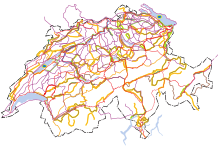SwitzerlandMobility
SwitzerlandMobility is the national network for non-motorized private transport, especially for leisure and tourism in summer and winter.
Through the project, SwitzerlandMobility aims to promote non-motorized individual transport and its combination with public and private transport. Important goals are to ensure long-term, high-quality national LV route offerings with spatial planning and financial resources, to increase the competitiveness of tourist Switzerland and to create high economic benefits in all parts of the country, especially in rural areas.
Characteristic
Non-motorized private transport, officially known as " slow traffic " in Switzerland, means hiking, cycling, mountain biking, skating, canoeing, snowshoeing and cross-country skiing. SwitzerlandMobility is an offer for tourists in the areas of hiking, cycling, mountain biking, skating, paddling, snowshoeing, cross-country skiing and sledding. The project was launched in 1998. Working groups from the working group Wanderland, Naturfreunde Schweiz , Swiss Alpine Club , Inventory of Historic Traffic Routes in Switzerland , Swiss Tourism Association , Switzerland Tourism , Veloland Switzerland and Wanderland Switzerland are involved. The development phase will end in summer 2008; the signs began in March 2008. Since 2017 there have also been uniformly signposted offers for the winter.
SwitzerlandMobility consists of the respective theme countries:
summer
- Hiking in Switzerland
- Cycling in Switzerland
- Mountain bike country Switzerland
- Skating country Switzerland
- Canoeing Switzerland
- Obstacle-free paths
winter
- Winter hiking
- Snowshoeing
- Cross-country skiing
- Sledging
Switzerland now has a dense network of long-distance routes for hikers, cyclists, mountain bikers, inline skaters, canoeists, snowshoeers, cross-country skiers and tobogganists, which is unique in the world.
history
Solothurn cycle path
On the occasion of the 700th anniversary of the Swiss Confederation , the painter Markus Caprione and the photographer Thomas Ledergerber, both enthusiastic cyclists, submitted the project "Solothurn Cycle Paths" to the CH91 office of the canton of Solothurn, which was accepted to their amazement.
In May 1993, the 300 km long cycle path, signposted with 1300 signs, was opened.
Cycling in Switzerland
In 1992, Capirone and Ledergerber founded the Velobüro Olten, which was soon to be reinforced by other people, and dedicated themselves to the idea of implementing a network of cycle paths for all of Switzerland. The Velobüro found a well-connected ally in the Swiss Tourism Association . Together we managed to convince the relevant federal authorities and all cantons of the project.
In 1995 the Veloland Switzerland Foundation was established as a project sponsor. Members: Cantons, federal government, ST, SBB, STV, SLS, SRB, ATB, TCS, VCS, IG Velo, others. Cycling in Switzerland was planned and implemented on behalf of the cantons.
In 1998, Swiss Federal Councilor Adolf Ogi opened Veloland Switzerland . When it was launched, 9 national routes with a total length of 3000 km were implemented, which were uniformly signaled throughout Switzerland.
Expo 02
The Velolandschweiz Foundation participated in Expo.02 with the “Human Powered Mobility” project . In this context, the Slowup was developed as a regional car-free experience day and was held for the first time in 2000.
SwitzerlandMobility project
In 1999 the Swiss hiking trails contacted the Veloland Switzerland Foundation and suggested that something similar be implemented for hiking based on the Veloland model. In the discussions that followed, the idea for SwitzerlandMobility arose: the development of a nationwide non-motorized traffic network for leisure and tourism, supported by all the associations, federal offices, cantons and tourism organizations concerned.
In 2008, the SwitzerlandMobility project was launched after a three-year implementation period. The forms of mobility hiking country, cycling country, mountain bike country, skating country and canoeing have been integrated.
In the early years, the focus was on printed maps and guides for communication. In 2008, when it was launched, 50,000 route guides were sold, but information on the routes was already made available on the schweizmobil.ch website at that time. The SwitzerlandMobility smartphone APP was also published in 2012. The importance of the online platform increased rapidly. In the anniversary year 2018, the website and APP recorded 13 million visitors.
In 2013, obstacle-free paths were integrated as a new category. SwitzerlandMobility is therefore also open to people with mobility disabilities.
Expansion into winter
In 2017, winter hiking, snowshoeing, cross-country skiing and sledging were expanded to include winter mobility. When it was launched in December 2017, 500 routes were integrated.
Signaling
Each sport is specially signaled. Each sport is divided into national and regional, and in some cases also local, routes. The national routes are planned for several days, the regional routes for two to three hours.
Individual evidence
- ↑ Slow traffic: Federal Roads Office FEDRO
- ↑ Homepage: SwitzerlandMobility Summer
- ↑ Homepage: SwitzerlandMobility Winter
- ↑ Velojournal, No. 4, 1993, pp. 6/7
- ↑ Tagesschau main edition, Schweizer Fernsehen DRS, edition of June 1, 1998
- ↑ site schweizmobil.org. Retrieved April 3, 2020 .
- ↑ Schweizmobil, survey on usage 2013 https://www.schweizmobil.org/dam/jcr:9db7dfb8-82f0-4ab8-bdd6-7e92e375f97f/20150703_SchweizMobil_Erstieg_zur_Nutzen.pdf
- ↑ SwitzerlandMobility Info 2019 https://www.schweizmobil.org/dam/jcr:10b1c559-075c-441d-bb7b-702ff1849cc2/2019-SchweizMobil-Info.pdf
